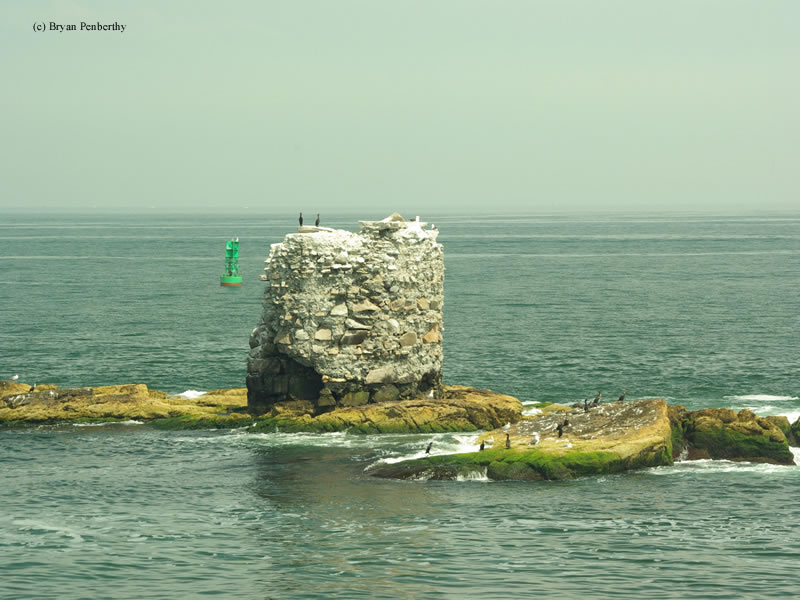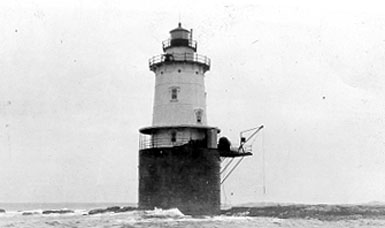Whale Rock Lighthouse
Narragansett, Rhode Island - 1882 (1882**)

History of the Whale Rock Lighthouse
Posted/Updated by Bryan Penberthy on 2012-11-06.
A large pile of rocks that sits just above the water's surface in the middle of the west channel of Narragansett Bay gives the appearance of a whale surfacing. This is how the navigational nightmare that is Whale Rock got its name.
Many vessels have foundered on the rocks, with one such ship being the schooner Pearl. It struck the reef in January of 1867 and sunk. With only the main mast above the water, Captain Benjamin Hudson survived by clinging to it until his rescue the following day. The other five men aboard the schooner perished.
A lighthouse was proposed for the rock structure as early as 1871; however, funds would not be set aside for another ten years when Congress appropriated $35,000. Work started by crews cutting a large ring into the rocks which would accept the cast-iron caisson. The caisson was then filled with concrete.
 Whale Rock Lighthouse circa 1882 (Courtesy CG).
Whale Rock Lighthouse circa 1882 (Courtesy CG).
Construction was slow as work could only be completed during low tide and calm seas. Due to the slow pace, the foundation was the only part to be completed before work halted for the winter. The four-story cast-iron tower which was similar in style to the Butler Flats Lighthouse in Massachusetts was completed the following year. It would display its light for the first time on October 1, 1882.
The Annual Report of the Lighthouse Board had the following entry:
145. Whale Rock, entrance to Narragansett Bay, Rhode Island - The work at this important station was well advanced at the close of the last fiscal year. The structure, consisting of an iron pier surmounted by a cast-iron tower and lantern, with accommodations for the keeper, was completed during the year, and was lighted on October 1, 1882, for the first time.
Although most off-shore lighthouses were never considered a desirable post, Whale Rock with full exposure to the open ocean, would have definitely been near the top of the list of least desirable stations. Wind and weather frequently prevented keepers from heading to or returning from the mainland. Although the first keeper, Nathaniel Dodge, served at the post for four years, the rest of the keepers to serve Whale Rock would last on average a little over a year.
Many keepers have reported the ferociousness of the sea on the exposed station. Waves frequently crashed against the port-hole windows which were four-stories above the sea. On occasion, gutters and railings were ripped from the station. But none of that compares to the Great Hurricane of 1938.
The Great Hurricane of 1938 would start as a category 5 storm in the open Atlantic. But by the time it made landfall in the Northeast, it would be downgraded to a category 3 with gusts reaching 121-mph. Like many of the other lighthouses on the Atlantic coast such as the Beavertail and Saybrook Breakwater, Whale Rock Lighthouse took a direct hit.
The morning of September 21, 1938 started like many other days, the seas were calm with a light wind. Assistant Keeper Walter Eberle, a twenty year Navy veteran and master diver, had noticed that the winds were picking up, and left for the Whale Rock Lighthouse a little early to relieve Keeper Daniel Sullivan.
As each successive wave came in and crashed against the tower, it grew weaker and weaker. The final straw came in the form of what witnesses describe as a tidal wave which tore the tower off of the concrete caisson and sent it into the sea. The basement, basement stairs, concrete deck and kitchen floor were still intact. Everything else was destroyed or missing. The upper-half of the tower as well as Keeper Eberle's body would never be found. The Lighthouse Digest has more information on Keeper Walter B. Eberle and his service at Whale Rock Lighthouse in the following article.
The tower would never be rebuilt, and the pieces of the tower that remained after the storm were removed. A steel tower was erected on the remains of the caisson that would show a green light powered by acetylene. It was replaced in 1988 by a lighted buoy which is visible in the picture above.
Reference:
- Northeast Lights - Lighthouses and Lightships, Robert G. Bachand, 1989.
- America's Atlantic Coast Lighthouses (6th edition), Jeremy D'Entremont, 2005.
- Annual Report of the Light House Board, U.S. Lighthouse Service, Various years.
- New England Lighthouses: A Virtual Guide website.
- Guardians of the Lights: Stories of US Lighthouse Keepers, Elinor De Wire, 1995.
- "A Battle at Whale Rock," Jeremy D'Entremont, American Lighthouse Foundation, Unknown.
- "Whale Rock's Keeper Walter B. Eberle, 1898-1938," Jeremy D'Entremont, Lighthouse Digest, April 2001.
Directions: The lighthouse sits out in Narragansett Bay. The lighthouse is best viewed from the water. Rhode Island Bay Cruises offers a 10 lighthouse cruise that passes by the lighthouse.
Access: The lighthouse no longer exists.
View more Whale Rock Lighthouse picturesTower Height: 59.00'
Focal Plane: 73'
Active Aid to Navigation: Deactivated (1938)
*Latitude: 41.44400 N
*Longitude: -71.42400 W
See this lighthouse on Google Maps.
